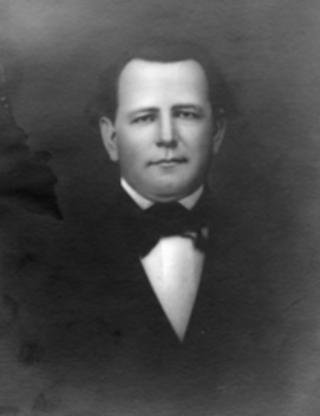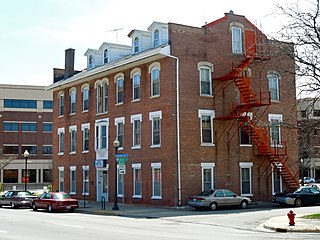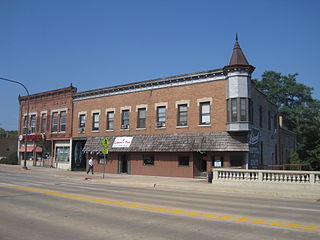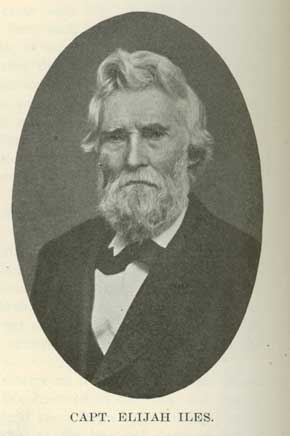
Galena is the largest city in and the county seat of Jo Daviess County, Illinois, United States. It had a population of 3,308 at the 2020 census. A 581-acre (235 ha) section of the city is listed on the National Register of Historic Places as the Galena Historic District. The city is named for the mineral galena, which was in the ore that formed the basis for the region's early lead mining economy.

John Pope was a United States Senator from Kentucky. He was a member of the United States House of Representatives from Kentucky, Secretary of State of Kentucky, and the third Governor of Arkansas Territory.

Joseph Naper, also known as "Joe Naper" and "Captain Joseph Naper" (1798–1862), was an early Illinois pioneer, ship captain, shipbuilder, businessman, surveyor, state militia officer, soldier, politician, and city planner. In 1831, Naper and his brother John were credited with founding Naper's Settlement. Besides Galena, Illinois (1827) and Dixon, Illinois (1830), Naper's Settlement was one of the oldest Illinois communities to be established west of Fort Dearborn, now Chicago. Naper's Settlement would be renamed Naperville, becoming the oldest town and first county seat of DuPage County, Illinois, later moved by county vote in 1868 and displaced by Wheaton.

John Marshall Hamilton was the 18th Governor of Illinois, serving from 1883 to 1885. Born in Union County, Ohio, Hamilton became interested in politics at a young age, joining the Wide Awakes when he was thirteen and the Union Army four years later. After graduating from Ohio Wesleyan University he studied law and was admitted to the bar. A notable attorney in Bloomington, Illinois, Hamilton was elected to the Illinois Senate in 1876. He served there until 1881, when he was elected Lieutenant Governor of Illinois on a ticket with Shelby Moore Cullom. When Cullom resigned after election to the United States Senate, Hamilton became Governor of Illinois. He was not selected as a candidate for re-election, but did serve that year as a delegate to the 1884 Republican National Convention. He spent the rest of his life as an attorney in Chicago, where he died in 1905.

Benjamin Stephenson was the Congressional Delegate for the Illinois Territory from 1814 until 1816, and a delegate to the Constitutional Convention that made it possible for Illinois to become a state.

First Capitol Historic Site is a free-admission historic museum located outside Belmont, Wisconsin, United States. The museum includes two of the buildings first used by legislators to meet in Wisconsin Territory. Currently owned and operated by the Wisconsin Historical Society, the site is listed on the National Register of Historic Places.

The Noble–Seymour–Crippen House is a mansion located at 5624 North Newark Avenue in Chicago's Norwood Park community area. Its southern wing, built in 1833, is widely considered the oldest existing building in Chicago. As well as the 22nd oldest in the state of Illinois.

The Nachusa House is a former hotel building in Dixon, Illinois, United States along Galena Avenue. The building was constructed in 1853 and operated continuously as a hotel until 1988. It underwent many alterations during the time it operated as a hotel. Following its period as a hotel the five-story mansard roofed building fell into disrepair and was nearly demolished in 1997. The building was restored by the Illinois Housing Development Authority and a Chicago developer at a cost of US$3.2 million and renovated into affordable housing for senior citizens. During its height the Nachusa House was a popular stop along rail and stagecoach lines and was a known layover for Abraham Lincoln. The Nachusa House was added to the U.S. National Register of Historic Places in 1983.

The Elihu Benjamin Washburne House, also known as the Washburne-Sheehan House, is a 1+1⁄2-story Greek Revival house located at 908 Third Street in Galena, Illinois. Constructed in 1844–45, the building was built for and owned by Elihu Benjamin Washburne, a prominent Galena lawyer who served in Congress during the American Civil War, and as Secretary of State and Minister to France under President Ulysses S. Grant, another famous Galenian. The Washburne House was added to the U.S. National Register of Historic Places in 1973.

The Galena Historic District is a historic district located in the city of Galena, Illinois, United States. The historic district encompasses 85 percent of the city of Galena and includes more than 800 properties. The downtown area consists of three successive tiers made up of Main, Bench and Prospect Streets. Within the boundaries of the district are such notable homes as the Ulysses S. Grant Home and the Elihu B. Washburne House. The Galena Historic District was added to the U.S. National Register of Historic Places in 1969.

Jesse Burgess Thomas Jr. was an American politician who served as Illinois Attorney General from 1835 to 1836 and later on the Supreme Court of Illinois.
The Galena–Chicago trail was a stagecoach route located in northern Illinois that ran from the mid-to-late 1830s until 1854. As indicated by its name, the route linked Chicago, located in the northeast of the state, with Galena which was located in the lead mining district of the northwest. The Chicago-Galena trail includes the "Stagecoach Trail" that runs between Galena and Lena, Illinois. East of Lena the stage route follows U.S. Route 20 and Business U.S. Route 20 through Eleroy, Freeport and Rockford to Belvidere. This road began as the old State Road number 2 established on 15 January 1836 and laid out by June 1837.

The Galena Hotel, originally known as the Fox River House, is a historic hotel in Aurora, Illinois. It is the oldest hotel still standing in the city.

The Elgin Historic District is a set of 697 buildings in Elgin, Illinois. Of these, 429 contribute to the district's historical integrity. The district is the oldest portion of the city, and contains mostly residences and churches. Other buildings in the district include an art museum, a masonic temple, and the Elgin Academy. Listed on the National Register of Historic Places in 1983, the district also contains three properties that were already individually listed: the academy, the First Universalist Church, and Gifford-Davidson House.
John Hawkins Rountree was an American farmer, businessman, politician, and Wisconsin pioneer. He was the founder of Platteville, Wisconsin, and was instrumental in the early development of that village. He was also one of the founders of the Northwestern Mutual Insurance Company, and remained a director in the company until his death. In politics, he represented Grant County for five years in the Wisconsin Legislature, and was a delegate to Wisconsin's 2nd constitutional convention in 1847.

The Belvidere North State Street Historic District is a historic district on the north side of the Kishwaukee River in Belvidere, Illinois. It is primarily composed of commercial building representative of architectural trends from 1865 to 1962. The district has remained largely intact since the mid-1930s.

Elijah Iles was an American businessman, pioneer, and politician who was one of the first settlers of Springfield, Illinois. He was elected to the Illinois Senate in 1826 and fought in the Winnebago and Black Hawk Wars. During the latter engagement, Iles commanded future President Abraham Lincoln.
William Brown was an English American businessman and politician. He served one term in the Illinois House of Representatives from 1864 to 1866, then was elected mayor of Rockford, Illinois for one term. Brown was elected to the Illinois Circuit Courts in 1870 and served there until his death in 1891.

Mark T. Skinner was an American politician, attorney, and philanthropist from Vermont. The son of a Vermont politician and judge, Skinner decided to follow his father into the legal profession. He moved west to Chicago, Illinois, and was named City Attorney for Chicago and United States Attorney for the Illinois District. In 1846, Skinner was elected to a term in the Illinois House of Representatives. During the Civil War, during which he lost his only son, Skinner served on the United States Sanitary Commission and oversaw a similar organization in Chicago. After retiring from law and politics, he managed real estate and focused on charitable endeavors.
William Fithian was an American physician and politician reputedly born in Cincinnati, Ohio. Moving to Danville, Illinois after success in medicine, he became a supporter of the Whig Party. Fithian served in the Illinois General Assembly for ten years, mostly in the Senate. A supporter of Abraham Lincoln, Fithian was appointed a Provost Marshal for the Civil War.



















